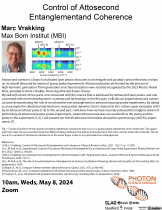Join from PC, Mac, Linux, iOS or Android: https://stanford.zoom.us/j/93937949420?pwd=WnVibjk1N2xkWFRvbkU5NFRGR1ZTZz09
Password: 836315
Or iPhone one-tap (US Toll): +18333021536,,93937949420# or +16507249799,,93937949420#
Or Telephone:
Dial: +1 650 724 9799 (US, Canada, Caribbean Toll) or +1 833 302 1536 (US, Canada, Caribbean Toll Free)
Meeting ID: 939 3794 9420
Password: 836315
International numbers available: https://stanford.zoom.us/u/acO0zgCjw6
Meeting ID: 939 3794 9420
Password: 836315
SIP:
Password: 836315
Speaker: Marc Vrakking, Max Born Institut (MBI)
Program Description
Attosecond science is a branch of ultrafast laser physics that aims to investigate and possibly control electronic motion on its natural timescale by means of pump-probe experiments. Attosecond pulses are formed by the process of high-harmonic generation. Their generation and characterization were recently recognized by the 2023 Physics Nobel Prize, awarded to Anne L’Huillier, Pierre Agostini and Ferenc Krausz.
My talk will consist of two parts, one concerned with the science that is addressed by attosecond laser pulses, and one concerned with recent developments in attosecond technology. In the first part, I will discuss experimental and numerical work demonstrating the role of ion-photoelectron entanglement in attosecond pump-probe experiments, by taking as an example the vibrational and electronic wave packet dynamics that is induced in H2+ cations upon ionization of H2 by an attosecond laser pulse [1-4]. In the second part, I will show how we have recently achieved the longtime dream of performing all-attosecond pump-probe experiments, where attosecond pulses are used both as the pump and the probe in the experiment [5, 6]. I will present our first all-attosecond transient absorption spectroscopy (AATAS) experiments [7].
References
[1] M.J.J. Vrakking, Control of Attosecond Entanglement and Coherence. Physical Review Letters, 2021. 126(11): p. 113203.
[2] L.-M. Koll, et al., Experimental Control of Quantum-Mechanical Entanglement in an Attosecond Pump-Probe Experiment. Physical Review Letters, 2022. 128(4): p. 043201.
[3] M.J.J. Vrakking, Ion-photoelectron entanglement in photoionization with chirped laser pulses. Journal of Physics B-Atomic Molecular and Optical Physics, 2022. 55(13).
[4] L.-M. Koll, et al., The role of ion-photoelectron entanglement in electron localization following attosecond ionization of H2 (working title). (in preparation), 2024.
[5] Major, B., et al., Compact intense extreme-ultraviolet source. Optica, 2021. 8(7): p. 960-965.
[6] Kretschmar, M., et al., Compact realization of all-attosecond pump-probe spectroscopy. Science Advances, 2024. 10(8).
[7] Svirplys, E., et al., All-attosecond transient absorption spectroscopy (working title). (in preparation), 2024.





